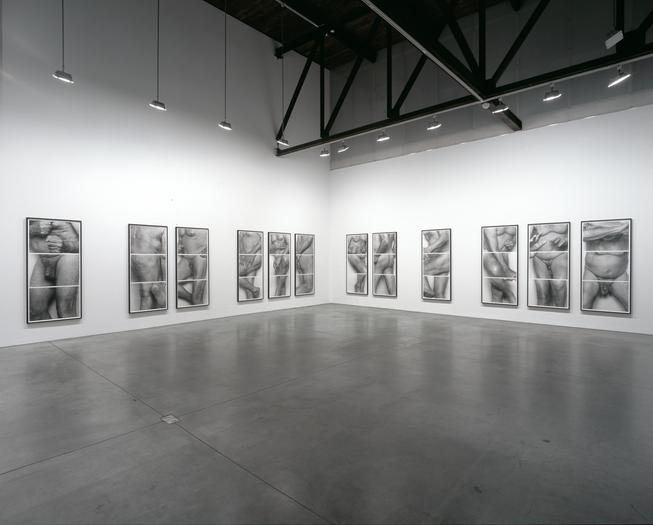John Coplans
Serial Figures
May 21 – June 26, 2004
Main Gallery
"I photograph my body. I generalize it by beheading myself to make my body more like any other man's. Nakedness removes the body from the specificity of time; unclothed, it belongs to the past, present and future. It is classless, without country, unencumbered by language, and free to wander across cultures at will. ...All my images are atavistic. They seem to refer to distant models and to numerous sources. At one moment, I may echo the Venus of Willendorf or a fragment of a warrior from the Parthenon. My imagery is not bound by rules; I wander freely throughout the history of art." (John Coplans, in A Body)
This exhibition, of the last body of work John Coplans made before his death last year at the age of 83, is one of several celebrations of his life and work this month. Our Gallery 2 exhibition remembers Coplans' distinguished careers as a writer, curator and editor, while at Per Skarstedt Fine Art some of his early and best-known works as a photographer are currently on view. A memorial service held on May 20 made apparent Coplans' talent for gathering the best and brightest minds around him, as friends and colleagues from every era of his long and colorful life paid tribute to his unconventional brilliance.
One of the most arresting qualities of the Serial Figures is their dynamism and vigor, all the more remarkable since these were Coplans' final works. Faced with gradual loss of sight in his last years, Coplans' realisation that seeing is in fact a function of the mind's eye allowed him to continue to make images. Since 1980 he had explored the terrain of his own aging body, but this last group of work nevertheless breaks new territory. We see a blur of motion for the first time, as Coplans strikes towards the camera, and the dramatic foreshortening of projecting limbs. In most of the poses he is balanced on one foot, caught in the act of a lunge, a turn, a kick or a punch. Also for the first time, a tantalizing glimpse of the artist's head enters the frame – a stubbled chin, shielded by upraised arms. These postures, sometimes aggressive, sometimes defensive, are choreographed in a continuous frieze of movement. Coplans made the sequence to be variable, and the rhythms within it fluid and changeable.
Coplans' career as a photographer began at the age of sixty. The extraordinary contribution he made to the art world in his life before that date is remembered in the exhibition in Gallery 2, through some of Coplans' many publications and the work of some of the artists with whom he was particularly connected. These include Andy Warhol and Roy Lichtenstein, both of whom were given their first solo museum shows by Coplans; Robert Smithson and Ellsworth Kelly, on whom he published seminal books; and George Ohr and Carleton Watkins, both of whom John collected himself. Considering the vast range of Coplans' knowledge of the history of art, and his tough and brilliant criticism of the greatest artists, one marvels at his courage in taking the risk of making his own work. One also understands how deeply his own work is informed by that breadth of knowledge and critical insight; how, for example, the curator of the 1968 show "Serial Imagery", and writer of the first critical investigation into that art form, could become the creator of the Serial Figures hanging in the next gallery.
